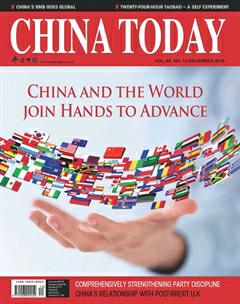China Speed
By+staff+reporter+ZHOU+LIN
ON February 23, 2016, American reporter Julie Makinen wrote an article entitled “Ushering in the Year of the Monkey at 180 mph on Chinas Bullet train,” sharing her personal experience of travelling on train G609 on Chinas lunar New Year. It was published in the Los Angeles Times:
“Nine years ago, China had not one such bullet train in service.
“A cartoon woman pops onto the onboard TV screens and begins reciting some statistics: ‘By the end of 2015, China had 19,000 kilometers of highspeed track in operation, the most in the world. That is over 60 percent of all high-speed rails in the world.
“An orange digital display at the front of the car tracks our acceleration: 290 km/h, 291 km/h, 297 km/h...”
Julies story reminds me that Chinas high-speed rail, or“China Speed,” has become an important symbol of Chinas development since the implementation of the reform and opening-up policy in the late 1970s.
From the invention of the wheel over 6,000 years ago, to the proliferation of automobiles, trains, steam boats, and planes in daily life, modes of transportation have transformed living spaces and lifestyles at an everaccelerating pace. High-speed railways create the illusion of lengthening lives by saving time.
Chinas high-speed railways now act as a “golden business card,” introducing Chinas manufacturing capabilities to the world, and the idea of“China Speed” represents Chinese peoples aspirations and their determination to create a prosperous society.
A new book, China Speed: Development of Chinas HighSpeed Rail, recently published by Foreign Languages Press (in both Chinese and English versions), showcases the achievements of Chinas high-speed rail system which has received so much attention throughout the international community. Attractively presented, with vivid pictures and informative text, China Speed appeals to an international readership, and introduces the talents of top Chinese companies involved in the story of highspeed railway development.
The author, Wang Xiong, studied Chinese Literature at the Suzhou Railway Institute and began his writing career in 1989. Now, Wang is a member of the Chinese Writers Association and vice chairman of the Chinese Railway Writers Association. He has worked as a train driver, publicist and reporter and currently works at Peoples Rail magazine. For Wang, recounting the history of Chinas high-speed railways is like sifting through treasured family heirlooms.
Wang was literally part of the construction of this history, and as an eyewitness he was able to amass copious historical records, first-hand interviews, and some very revealing documents to reconstruct the track of Chinas railway development. The early days were hard and the work was complicated, but the eventual triumph reflects the tenacity of the socialist work ethic –uniting in strength to achieve a common goal. The book offers an authoritative history of Chinese high-speed rail for overseas readers.
Six highly informative chapters delve into such topics as the need for high-speed rails, the start of the high-speed era, how high-speed technology was developed, and how the whole system works. Wang Xiong adds personal anecdotes in an introduction and an epilogue, giving greater insight into his personal passion for railways and his lifelong love affair with trains.
“China Speed” is what drives the progress of the times. High-speed rail development in China is attracting admiration from countries around the world. China is a global leader in engineering high-speed railway bridges, tunnels, track, and roadbeds, as well as Electric Multiple Unit (EMU) technology. It is also in the forefront in the design, construction, and operation of high-speed rails, scoring high on the five indicators of safety, reliability, applicability, cost-efficiency and advanced technology.
China now boasts the largest operational high-speed rail network in the world. The network has become a matter of national pride and a cultural icon. It also supports other national incentives such as “China Creation,”“China Intelligence,” “China Strength,” “China Pride,” and“China Spirit.” The so-called China speed is transforming the landscape, not just of China, but of the world.
As Julie Makinen wrote as her train hurtled through the Taihang Tunnel: “Amid Chinas breakneck development, one mind-blowing accomplishment quickly blurs into the next. Yes, Taihang Tunnel is currently Chinas longest rail tunnel, but it wont be for long. It will soon drop to No. 3 with the opening of the 20.28-mile Xinguanjiao Tunnel in Qinghai Province, and the 17.54-mile West Qinling Tunnel in Gansu.”
The high-speed rail network in China is widely recognized as the symbol of the phenomenal speed of Chinas development, both at home and abroad.

